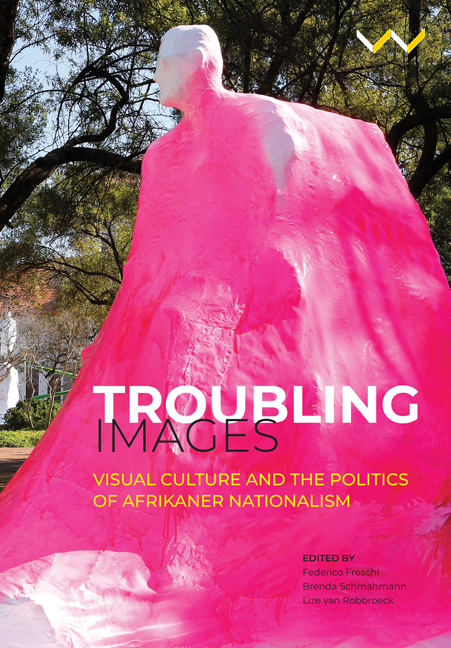Book contents
- Frontmatter
- Contents
- Acknowledgements
- List of Illustrations
- Troubling Images: An Introduction
- 1 The Trajectory and Dynamics of Afrikaner Nationalism in the Twentieth Century: An Overview
- One Assent and Dissent Through Fine Art and Architecture
- Two Sculptures on University Campuses
- Three Photography, Identity and Nationhood
- Four Deploying Mass Media and Popular Visual Culture
- Contributor Biographies
- Index
Troubling Images: An Introduction
Published online by Cambridge University Press: 21 March 2020
- Frontmatter
- Contents
- Acknowledgements
- List of Illustrations
- Troubling Images: An Introduction
- 1 The Trajectory and Dynamics of Afrikaner Nationalism in the Twentieth Century: An Overview
- One Assent and Dissent Through Fine Art and Architecture
- Two Sculptures on University Campuses
- Three Photography, Identity and Nationhood
- Four Deploying Mass Media and Popular Visual Culture
- Contributor Biographies
- Index
Summary
In the conclusion of his book Banal Nationalism, Michael Billig writes, ‘If the future remains uncertain, we know the past history of nationalism. And that should be sufficient to encourage a habit of watchful suspicion’ (Billig 1995, 177). This warning has perhaps never been truer or more relevant than in the second decade of the new millennium, which has been characterised by a marked turn towards right-wing populism and nationalism. The list of resurgent nationalisms declaring themselves in exclusionary ethnic, cultural or religious terms is long and growing. Obvious examples include the United States President Donald Trump's social media-led demagoguery vowing to ‘Make America Great Again’ through isolationism and protectionism, regardless of the cost to international relations, and the patriotic posturing and diplomatic dithering that has characterised the United Kingdom's ‘Brexit’ negotiations with the European Union. We have witnessed, too, an upsurge of right-wing politics – with its attendant xenophobia, Islamophobia, and echoes of anti-Semitism – in East-Central Europe, and the unapologetic chauvinism and barely disguised expansionist ambitions of Russian President Vladimir Putin; Prime Minister Narendra Modi's ‘Hindu-first’ rewriting of nationalist history in India at the expense of multiculturalism; the official relegation of Arabs to the rank of second-class citizens in Israel by the Knesset's declaration of the Jewish nation-state law that effectively declares that only Jews have the right of self-determination in the country. Individually and collectively, these right-wing trends sound a worrying tocsin that when liberal democracy fails to find a sufficiently broad base and democratic governance is seen to fail, authoritarianism – and the attendant erosion of civil rights and liberties of those who do not fit a narrow definition of national ‘belonging’ – is never far behind.
The consensus among political commentators seems to be that this rising tide of nationalism is a backlash against the complacency and elitism of successive post-Cold War governments. Ordinary citizens were left unprotected from the effects of rampant neoliberal economic policies, which had seemingly not anticipated the social, economic and cultural effects of migration, whether forced or otherwise. These combined forces have also given rise, as William A Galston (2018) argues, to a ‘wave of discontent [that] also taps into long-standing fears about globalisation and a dilution of national identity’. In time, he argues, ‘the rise of anti-immigrant, anti-internationalist sentiment … could have grave consequences for liberal democracy itself’.
- Type
- Chapter
- Information
- Troubling ImagesVisual Culture and the Politics of Afrikaner Nationalism, pp. 1 - 22Publisher: Wits University PressPrint publication year: 2020



